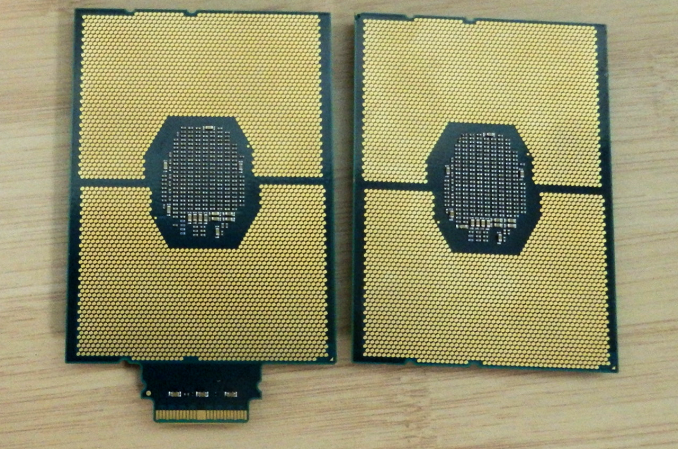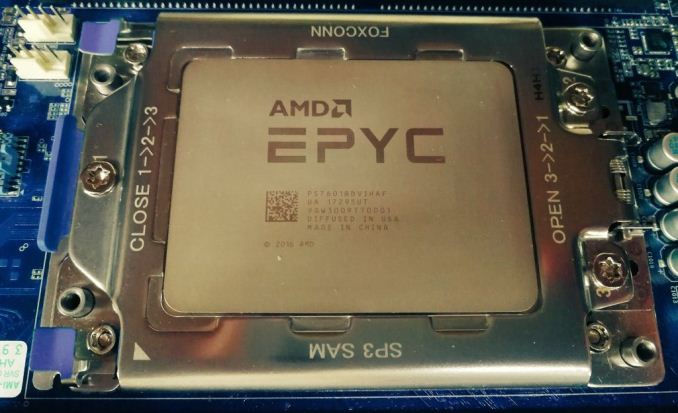Dissecting Intel's EPYC Benchmarks: Performance Through the Lens of Competitive Analysis
by Johan De Gelas & Ian Cutress on November 28, 2017 9:00 AM EST- Posted in
- CPUs
- AMD
- Intel
- Xeon
- Skylake-SP
- Xeon Platinum
- EPYC
- EPYC 7601
Conclusion
First of all, Intel's benchmarks lend further support to what we already suspected: Intel's Scalable Xeon is better at serving databases for a number of reasons: better data locality (fewer NUMA nodes), better single-threaded performance, and a more "useable" cache. The claim that Intel offers much more predictable database performance seems very reasonable to us: the EPYC platform is much younger and much more complex to tune as it is a "virtual 8 socket" system.
Secondly it is true that the Intel Scalable Xeon is more versatile: the past 5 years AMD's presence in the server market was neglible, while Intel has been steadily adding virtualization features (posted interrupts), I/O features and more (TSX for example). Many of these features are now supported by the hypervisor and OSes out there.
The EPYC platform has some catching up to do. Firmware updates and other software updates were necessary to run a hypervisor, and only relatively recent versions of the Linux kernel (February 2017 w/4.10+) have support for the EPYC processor. So even if we doubt that the 8160 can really deliver 37% better performance than the AMD EPYC in the real world, there is no denying that the Intel Xeon is a "safer bet" for VMware virtualization.
Nevertheless, it is interesting to see that Intel admits that there are quite a few use cases out there where AMD has an advantage. The AMD EPYC has a performance per dollar advantage in webserving and Java servers, for example.
Otherwise, there is some merit to the claim that AVX-512 allows Intel to offer excellent HPC performance without the use of a GPU in compute intensive applications. At the same time, if you are after the best performance on these very parallel workloads, a GPU almost always offers several times higher performance. AVX-512 can also not save Intel in several bandwidth-intensive benchmarks such, as in fluid dynamics.

Intel Xeon-SP CPUs (Left: with Omni-Path)
One interesting element to the whole scenario is that at no point does Intel ever approach the performance per watt angle in these discussions. It leaves a big question unanswered from Intel - perhaps we should invoke Hanlon's Razor at this point and call it a missed opportunity, rather than suggest that Intel does not want to speak about power. Our own results showed a win for AMD's EPYC here though, when comparing two 145W Xeon 8176 parts to two 180W EPYC 7601 parts. More testing on specific workloads is needed.
In summary, Intel makes several good points, even when those points aren't always in their own favor. The company clearly has an interest in ensuring that the Xeon's performance leadership remains well-known in light of AMD's EPYC-fueled resurgence, and while there's nothing altruistic about Intel's benchmarking, they are working from a sound position. Still, in defending their position – and by extension their high margins – Intel does highlight the Xeon's biggest weakness versus the EPYC in this newly competitive market: the Skylake Xeon can offer excellent performance, but that performance comes with an equally heavy price tag.

















105 Comments
View All Comments
lefty2 - Tuesday, November 28, 2017 - link
When Skylake runs AVX 512 and AVX2 instructions it causes both the clock frequency to go down *and* the voltage to go up. (https://www.intel.com/content/dam/www/public/us/en... However, it can only bring the voltage back down within 1ms. If you get a mix of AVX2 and regular instructions, like you do in the POV ray test, then it's going to be running on higher voltage the whole time. That probably explains why the Xeon 8176 drawed so much more power than the EPYC in your Energy consumption test.The guys at cloudflare also observed a similar effect (although they only notice the performance degrade): https://blog.cloudflare.com/on-the-dangers-of-inte...
Kevin G - Tuesday, November 28, 2017 - link
In the HPC section, the article indicates that NAMD is faster on the Epyc system but the accompanying graphic points toward a draw with the Xeon Gold 6148 and a win for the Xeon Platinum 8160. Epyc does win a few benchmarks in the list prior to NAMD though.Frank_han - Tuesday, November 28, 2017 - link
When you run those tests, have you bind CPU threads, how did you take care of different layers of numa domains.UpSpin - Tuesday, November 28, 2017 - link
HIghly questionable article:"A lot of time the software within a system will only vaguely know what system it is being run on, especially if that system is virtualised". Why do you say this if you publish HPC results? There the software knows exactly whay type of processor in what kind of configuration it is running.
"The second is the compiler situation: in each benchmark, Intel used the Intel compiler for Intel CPUs, but compiled the AMD code on GCC, LLVM and the Intel compiler, choosing the best result" More important, what type of math library did they use? The Intel MKL has an unmatched optimization, have they used the same for the AMD system?
"Firstly is that these are single node measurements: One 32-core EPYC vs 20/24-core Intel processors." Why don't you make it clear, that by doing this, the benchmark became useless!!! Performance doesn't scale linearly with core count: http://www.gromacs.org/@api/deki/files/240/=gromac...
So it makes a huge difference if I compare a simulation which runs on 32 cores with a simulation which runs on 20 cores. If I calculate the performance per core then, I always see that the lower core CPU is much much faster, because of scaling issues of the simulation software. You haven't disclosed how Intel got their 'relative performance' value.
Elstar - Tuesday, November 28, 2017 - link
Do we know for sure that the Omni-Path Skylake CPUs actually use PCIe internally for the fabric port? If you look at Intel's "ark" database, all of the "F" parts have one fewer UPI links, which seems weird.HStewart - Tuesday, November 28, 2017 - link
I think this was a realistic article on analysis of the two systems. And it does point to important that Intel system is more mature system than AMD EPYC system. My personally feeling is that AMD is thrown together so that claim core count without realistically thinking about the designed.But it does give Intel a good shot in ARM with completion and I expect Intel's next revision to have significantly leap in technology.
I did like the systems for similarly configured - as the cost, I build myself 10 years a dual Xeon 5160 that was about $8000 - but it was serious machine at the time and significantly faster than normal desktop and last much longer. It was also from Supermicro and find machine - for the longest time it was still faster than a lot machine you can get at BestBuy - it has Windows 10 on it now and still runs today - but I rarely used it because I like the portability of laptops
gescom - Tuesday, November 28, 2017 - link
https://www.servethehome.com/wp-content/uploads/20...And suddenly - 8 core 6134 Skylake-SP - equals - 32 core Epyc 7601.
Amazing. Really amazing.
gescom - Tuesday, November 28, 2017 - link
Huh, I forgot - and that is Skylake at 130W vs Epyc at 180W.ddriver - Tuesday, November 28, 2017 - link
Gromacs is a very narrow niche product and also very biased - they heavily optimize for intel and nvidia and push amd products to take an inefficient code path.HStewart - Tuesday, November 28, 2017 - link
This is comparison with AVX2 / AVX512AVX512 is twice as wide as AVX2 and significant more power than the AVX2 - so yes it very possible in this this test that CPU with 1/4 the normal CPU cores can have more power because AVX512.
Also I heard AMD's implementation of AVX2 is actually two 128 bits together - these results could show that is true.